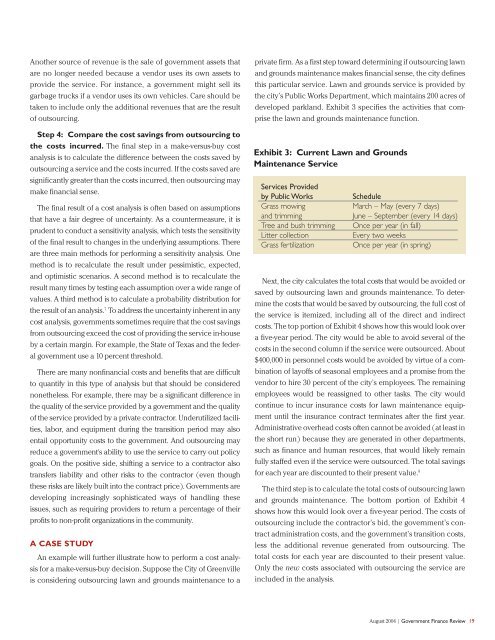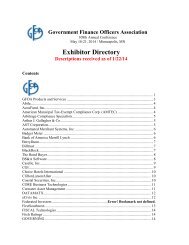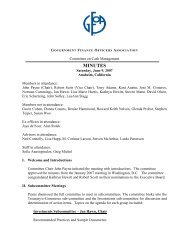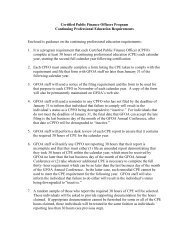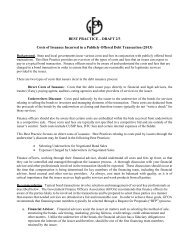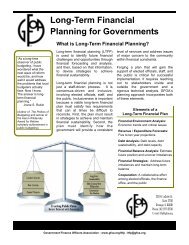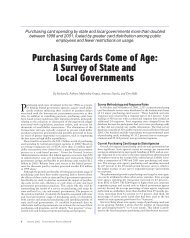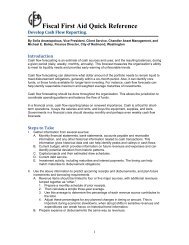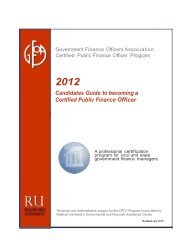Editor's note - Government Finance Officers Association
Editor's note - Government Finance Officers Association
Editor's note - Government Finance Officers Association
You also want an ePaper? Increase the reach of your titles
YUMPU automatically turns print PDFs into web optimized ePapers that Google loves.
Another source of revenue is the sale of government assets that<br />
are no longer needed because a vendor uses its own assets to<br />
provide the service. For instance, a government might sell its<br />
garbage trucks if a vendor uses its own vehicles. Care should be<br />
taken to include only the additional revenues that are the result<br />
of outsourcing.<br />
Step 4: Compare the cost savings from outsourcing to<br />
the costs incurred. The final step in a make-versus-buy cost<br />
analysis is to calculate the difference between the costs saved by<br />
outsourcing a service and the costs incurred. If the costs saved are<br />
significantly greater than the costs incurred, then outsourcing may<br />
make financial sense.<br />
The final result of a cost analysis is often based on assumptions<br />
that have a fair degree of uncertainty. As a countermeasure, it is<br />
prudent to conduct a sensitivity analysis, which tests the sensitivity<br />
of the final result to changes in the underlying assumptions. There<br />
are three main methods for performing a sensitivity analysis. One<br />
method is to recalculate the result under pessimistic, expected,<br />
and optimistic scenarios. A second method is to recalculate the<br />
result many times by testing each assumption over a wide range of<br />
values. A third method is to calculate a probability distribution for<br />
the result of an analysis. 7 To address the uncertainty inherent in any<br />
cost analysis, governments sometimes require that the cost savings<br />
from outsourcing exceed the cost of providing the service in-house<br />
by a certain margin. For example, the State of Texas and the federal<br />
government use a 10 percent threshold.<br />
There are many nonfinancial costs and benefits that are difficult<br />
to quantify in this type of analysis but that should be considered<br />
nonetheless. For example, there may be a significant difference in<br />
the quality of the service provided by a government and the quality<br />
of the service provided by a private contractor. Underutilized facilities,<br />
labor, and equipment during the transition period may also<br />
entail opportunity costs to the government. And outsourcing may<br />
reduce a government's ability to use the service to carry out policy<br />
goals. On the positive side, shifting a service to a contractor also<br />
transfers liability and other risks to the contractor (even though<br />
these risks are likely built into the contract price). <strong>Government</strong>s are<br />
developing increasingly sophisticated ways of handling these<br />
issues, such as requiring providers to return a percentage of their<br />
profits to non-profit organizations in the community.<br />
A CASE STUDY<br />
An example will further illustrate how to perform a cost analysis<br />
for a make-versus-buy decision. Suppose the City of Greenville<br />
is considering outsourcing lawn and grounds maintenance to a<br />
private firm. As a first step toward determining if outsourcing lawn<br />
and grounds maintenance makes financial sense, the city defines<br />
this particular service. Lawn and grounds service is provided by<br />
the city’s Public Works Department, which maintains 200 acres of<br />
developed parkland. Exhibit 3 specifies the activities that comprise<br />
the lawn and grounds maintenance function.<br />
Exhibit 3: Current Lawn and Grounds<br />
Maintenance Service<br />
Services Provided<br />
by Public Works<br />
Grass mowing<br />
and trimming<br />
Tree and bush trimming<br />
Litter collection<br />
Grass fertilization<br />
Schedule<br />
March – May (every 7 days)<br />
June – September (every 14 days)<br />
Once per year (in fall)<br />
Every two weeks<br />
Once per year (in spring)<br />
Next, the city calculates the total costs that would be avoided or<br />
saved by outsourcing lawn and grounds maintenance. To determine<br />
the costs that would be saved by outsourcing, the full cost of<br />
the service is itemized, including all of the direct and indirect<br />
costs. The top portion of Exhibit 4 shows how this would look over<br />
a five-year period. The city would be able to avoid several of the<br />
costs in the second column if the service were outsourced. About<br />
$400,000 in personnel costs would be avoided by virtue of a combination<br />
of layoffs of seasonal employees and a promise from the<br />
vendor to hire 30 percent of the city’s employees. The remaining<br />
employees would be reassigned to other tasks. The city would<br />
continue to incur insurance costs for lawn maintenance equipment<br />
until the insurance contract terminates after the first year.<br />
Administrative overhead costs often cannot be avoided (at least in<br />
the short run) because they are generated in other departments,<br />
such as finance and human resources, that would likely remain<br />
fully staffed even if the service were outsourced. The total savings<br />
for each year are discounted to their present value. 8<br />
The third step is to calculate the total costs of outsourcing lawn<br />
and grounds maintenance. The bottom portion of Exhibit 4<br />
shows how this would look over a five-year period. The costs of<br />
outsourcing include the contractor’s bid, the government’s contract<br />
administration costs, and the government’s transition costs,<br />
less the additional revenue generated from outsourcing. The<br />
total costs for each year are discounted to their present value.<br />
Only the new costs associated with outsourcing the service are<br />
included in the analysis.<br />
August 2004 | <strong>Government</strong> <strong>Finance</strong> Review 19


